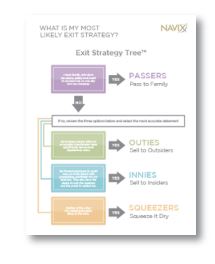
Archive for July, 2018
Four Simple Questions to Train Your Team to Bring Solutions Rather than Problems
There’s an old saying that problems arrive at your office door on two feet. Would your business be stronger and potentially grow faster if solutions, rather than problems, routinely arrived at your door? The answer is almost certainly yes. Plus, one of the biggest factors limiting value in many companies is management teams that can’t or won’t make important decisions without the owner. While there are undoubtedly strategic problems or decisions that only the owner/CEO can resolve, those should be the exception rather than the rule. A healthy organization cannot depend on owners to handle day-to-day, week-to-week problems, and challenges. Eventually, this dependency will slow your company’s growth. Worse, reliance on owners also makes it harder if not impossible to achieve successful exits.
Sometimes the root cause is employees who lack the experience and knowledge to make decisions and solve problems. Better hiring and training solves that issue. However, often the underlying cause is employees expecting owners to provide most if not all the solutions. (Ask yourself—are your employees avoiding making decisions and solving problems because of lack of skill or lack of will?) If your employees are just expecting you to make the decisions and solve the problems, then it’s time to change the environment. There are four simple, easy-to-learn questions that you can employ in discussions with your employees to facilitate this change.
The Four Questions
Imagine that an employee brings you a problem and nothing else. This habit means he or she expects you to solve the problem. If the problem is a crisis or highly time-sensitive, then address it and later debrief the situation with the employee. However, most issues are not so severe nor so immediate, therefore, once the problem and its two feet are in front of you, ask the first question:
QUESTION 1:
“(Employee Name), how do you recommend we resolve this?”
The first few times you pose this question, your people probably will not have a recommended solution; they are accustomed to you handling these matters. Whenever possible, send them away with instructions to come back by a specific deadline with a proposed solution. Do not accept responsibility for solving the issue or challenge, as that perpetuates a lack of accountability and ownership of the issue at hand. Soon, your higher performers will start providing recommended solutions when introducing problems. They will learn that not only do you require it but also that they relish the opportunity to contribute. Other employees may noticeably struggle with doing what you ask of them. Both responses reveal essential information about each employee’s skills, training, and confidence levels.
Once your people start offering recommended solutions, you will have to evaluate the merits of their ideas. Sometimes their recommendations will be suitable and effective, occasionally even better than whatever your solution might have been. In those cases, you’ve uncovered in that employee a great resource to tap into going forward. Other times, the proposed solution will be unsound or ineffective. If this occurs, you and your company still benefit because you have gained valuable insight into this person’s need for further training and development.
Once an employee has provided a recommended solution, proceed to the second question.
QUESTION 2:
“(Employee Name), what process did you follow to come up with your recommendation?”
Now that your team is proposing solutions introduce the second question. This question is just as important as the first because it reveals how thoroughly your employee has examined, researched, and evaluated the issue at hand. Did the employee shoot from the hip, or did the person exhibit a capacity for higher analysis and thinking? Of the four questions, the first question only tells you whether or not the employee can solve one particular issue. This second question tells you how well that employee can address multiple issues, both present, and future.
If the person’s answer indicates a well-thought process and approach, praise and encourage this person to keep at it. Offer any coaching ideas you may have. If this person’s response indicates a limited or flawed process, address that in the employee’s development and training going forward.
QUESTION 3:
“(Employee Name), I am curious—why did you bring this matter to me?”
The third question has the most potential to surprise you. With time, you likely will hear all kinds of answers, any of which can reveal much about this person’s perspective of himself or herself, of you, and about your organization. For example, you may hear something like, “Well, you’ve always handled these matters before…” If that is the answer, then you have just created an opportunity to bring desired change into the business. Alternatively, you may hear something like, “Well, I was not sure who else to bring this to…” Such a response uncovers a need for greater organizational clarity around roles and responsibilities. Do not be surprised if you even hear something like, “Well, I know I am supposed to bring this matter to (Joe), but frankly (Joe) just messes these things up, so I am bringing it to you instead…” Answers to this question can be painful but offer valuable insight into potentially deep-seated issues.
Note that it is important you preface your query with “I am curious…” or a similar phrase. It softens the question. You don’t want to come across as difficult to approach or closed off to your team’s needs.
QUESTION 4:
“(Employee Name), going forward, who do you feel should have the authority to handle this issue/situation/area?”
The fourth and final question opens the door for your people to tell you how they think your organization should be structured and how responsibilities should be delegated. There are only four possible answers. Each answer reveals something important about this person and your team. The four possible answers are:
- The employee asks for future authority to handle this matter
- The employee says you should continue to handle this issue
- The employee names somebody else in the organization, presumably because that person is most qualified in the employee’s eyes
- The employee says he or she does not know
Just like with the previous three questions, the employee’s answer gives insight into how the employee perceives the organization and what aspirations he or she has going forward. Your higher performing people who are eager to advance will likely nominate themselves (response A) to handle this issue and others like it in the future. You must then evaluate whether or not that person is ready for such responsibilities. How that employee has answered the three prior questions will help you make this decision. If he or she is ready for this responsibility, award it to them. Congratulations—you have just eliminated one source of problems coming to you on two feet. If he or she feels ready to handle the responsibility, but you disagree, then this event has opened the way for a frank discussion with this person about what he or she needs to do to earn the desired level of responsibility.
Employees who are unwilling or believe they are unready to handle this responsibility will typically answer the fourth question with response B (you should continue to be responsible) or response C (they nominate a co-worker.) The employee may be right, and if so move forward with their answer. Even in this situation, you and the organization have benefited from the four-question process because you’re now in clear and strong alignment with this employee on this issue. In other situations, you may disagree—you may see that this person could and should take on this responsibility. If that is the case, you now have a clear opportunity to coach the person and build up his or her skills and/or confidence in this area.
Lastly, if the employee has responded to the fourth question with the uncertainty of response D (he or she does not know), you may wish to determine if his or her answer is motivated by disinterest, inexperience, or hesitation to provide an opinion. The ambiguity of response D offers yet another opportunity to discuss the employee’s perceptions of your company and his or her role within it.
Conclusion
We recommend you print the four questions on a laminated card and discreetly place that card on your desk. Until you know the four questions from memory, the card will serve as your cheat sheet when a problem walks into your office. Within a few short months, you may see your culture and team change from one that brings you problems to one that brings solutions. Make your cheat sheet and start asking the four questions today.
At NAVIX, we know that a company is only as good as its leaders. Look at a company with sustained high performance, and you will find an effective leadership team that can devise and implement solutions, not just deliver problems. These four simple questions are but one tool we’ve developed to help you build a strong leadership team.
Contact us to discuss your exit goals and see how we can help you build a team that delivers them.
The One Exit Tactic You’ve Probably Never Heard Of
Selling your company to a strategic buyer. Private equity. ESOPs. IPOs. Intentionally defective grantor trusts. There seems to be a dizzying list of different ways to exit from your company. You have likely heard of most of them, and perhaps you are considering one versus another. Yet there might be one undervalued exit tactic that you have not heard of and need to know about. It is called a “non-control recap” in short vernacular (recap is an abbreviation of recapitalization). Here’s how it works and why it may help achieve your exit goals.
What is a Non-Control Recap?
Simply put, a non-control recap is selling a minority interest (non-controlling) portion of your company to an investor (recapitalization). Historically for mature companies, non-control investors were mostly private equity groups (PEGs), but family offices are an emerging player in this market. Non-control recaps are an alternative to a full sale of the company, although a full sale can still be pursued at a later date.
Why Consider a Non-Control Recap?
This exit tactic offers business owners a number of important advantages, particularly in comparison to selling the entire company. If you are your company’s sole owner, you can gain significant liquidity by taking home cash from the partial sale while continuing as a partial owner and leader of the company. You can reduce personal risk, as you diversify your net worth by gaining cash and potentially reducing or eliminating personal guarantees with an additional equity partner involved. Non-control investors prefer a passive role in the company, leaving you in control of day to day operations and decisions. With the right investor, you gain a valuable strategic ally in growing the company. Non-control investors may bring strategic opportunities to the company that were previously not available, such as opening new markets, introductions to prospective clients, or perhaps identifying and assisting with acquisitions for growth. Non-control investors typically require minority representation on your board, bringing experienced leaders to help the company to its next level of growth. Finally, you can remain the majority owner of the company until a later date, at which point you may choose to sell the entire company at your full and final exit, gaining another round of personal liquidity.
What If You Have Partners?
If you are not the company’s sole owner but have partners, the advantages of a non-control recap include all of the above, plus flexibility to customize the investment to the needs of individual co-owners. The level of liquidity can be tailored such that each co-owner can decide to sell some to all of his or her interest. The ongoing roles can be customized for each owner as well, permitting some to leave at closing and others to continue working in the company. A non-control recap can also be the vehicle for key management to own a portion of the company going forward, as a retention and incentivization strategy and/or as a stepping stone toward a future full sale of the company to the next generation of employee-owners.
Is There a Catch?
Non-control recaps are not for every owner or every company. Investors look for companies that are profitable, offer strong growth potential, and have capable leadership. While a minority investor remains hands-off mainly in the day to day operations, non-control investors will require supermajority rights on issues like selling the entire company or raising additional capital or debt. Another point to consider: the non-control sale may receive a lower valuation multiple than what might be achieved with a full sale, reflecting the investor’s minority position. However, this potential disadvantage is offset with the opportunity to pocket some liquidity now and retain ownership for the full sale at a later date–hopefully at a higher total valuation after having grown the company to the next level.
Non-control recaps may not be the right tool for every business owner, but they offer compelling advantages that should be considered prior to deciding to sell the entire company. To learn more, review our webinar on this topic called “Cashing Out Without Walking Out” or contact us to discuss your individual situation.
To discuss your unique business, and how to plan for and achieve a successful exit,
Call 772-210-4499 or email Tim to schedule a confidential, complimentary consultation.
Do You Really Need a Successor CEO? Here’s How to Know…
Ask a room full of business owners if they need a successor CEO on their team as part of their exit planning, and usually you will hear: “Yes,” “No,” “It Depends,” and “Maybe.” Surprisingly, each of these seemingly contradictory answers can be correct, depending on the business owner’s exit goals and situation.
Hiring and grooming a future CEO requires a major effort, and CEO-caliber leaders do not grow on trees. Therefore, it’s important to know if you need a successor CEO to achieve your exit goals because getting this wrong can derail your exit success. Here’s how to tell:
First, you must know your exit strategy. We recognize that there are four distinct exit strategies:
- Pass the business to family
- Sell to an outside buyer
- Sell to an inside buyer (one or more employees)
- Planned liquidation
 Determining your likely exit strategy gets you three-fourths of the way toward answering if you need a backup CEO. If your exit strategy is the first option—passing the business to family—then you must have a capable successor in position to achieve a successful exit. Without this, the company likely does not survive your exit. The same necessity exists if you intend to sell your business to an inside buyer, which is the third exit strategy from the list above. Without quality successor CEO leadership, selling to an inside buyer also will likely fail or never happen.
Determining your likely exit strategy gets you three-fourths of the way toward answering if you need a backup CEO. If your exit strategy is the first option—passing the business to family—then you must have a capable successor in position to achieve a successful exit. Without this, the company likely does not survive your exit. The same necessity exists if you intend to sell your business to an inside buyer, which is the third exit strategy from the list above. Without quality successor CEO leadership, selling to an inside buyer also will likely fail or never happen.
If your exit strategy is the fourth option, planned liquidation, then no need for a backup CEO exists. Under this strategy, you will wind down operations upon your exit.
Of the three exit strategies reviewed so far, two of them produce a “yes” answer to the question of needing a future CEO, and one leads to a “no” answer. That leaves “it depends” and “maybe” as the remaining answers, along with one final exit strategy to consider—selling to an outside buyer. If this is your exit strategy, then “maybe” you need a backup CEO, “depending” on your situation and goals.
Before proceeding, it helps to review the two types of outside buyers: strategic and financial. Strategic buyers are other operating companies that are either competitors or in a business that is sufficiently closely related to yours, that potential synergies exist. Financial buyers are not operating companies, but rather are investment firms such as private equity groups (PEGs) or family offices seeking to purchase companies for their investment portfolio.
Here’s why this matters. If you intend to sell your company to an outside buyer, somebody has to run the business after the sale. Strategic buyers might have quality leaders on their existing leadership teams they can deploy into your company after acquiring it. Given this, it might not be necessary to have a backup successor CEO on your team to sell your company to a strategic buyer.
In contrast, financial buyers typically don’t have leadership teams available to take over running your company. Whether you need a successor CEO or not, depends on your exit goals, when selling to a financial buyer. If your goals include a desire to quickly transition out of the company to pursue other interests or retire after the sale, you will need a successor CEO on the team. Alternatively, if you intend to continue with the company for at least several years after the sale, then selling to a financial buyer will not require a backup CEO because you will remain involved.
Selling to an outside buyer is the most common exit strategy. (Our research indicates about 70% of business owners intend to exit in this manner.) If you need a backup CEO will depend on who buys your business, and your exit goals. Having said this, keep in mind that few things add value to a company like having high-quality leaders. When selling to an outside buyer, even in situations where a successor CEO is not a full necessity, you still can benefit from having high caliber leaders on your team that your buyer can employ after the sale.
Business owners need to define their exit plans and goals, years before the desired exit, because finding, hiring, and training a successor CEO usually takes several years to accomplish. (Plus, there’s no guarantee you get the right hire on the first time.) Owners who get this question wrong often find themselves unable to achieve their exit goals, including working longer than intended. At NAVIX, our clients know their exit goals and are building leadership teams capable of achieving those goals. Contact us to schedule a free consultation to review our twenty-five step ‘Exit Readiness Scorecard™’ to measure how prepared you and your company are for the future exit.
To discuss your unique business, and how to plan for and achieve a successful exit,
Call 772-210-4499 or email Tim to schedule a confidential, complimentary consultation.
Free Fourth of July Gifts from NAVIX
Happy Fourth of July!
To help you celebrate and to provide some light reading while you relax this holiday week, download below any of our free and popular eBooks on helping business owners prepare for exit. While celebrating America’s freedom, learn how to reach your own financial freedom and exit successfully:
For all business owners:
- Your Last Five Years: How Your Final 60 Months Will Make or Break Your Exit Success
Ideally, you need to begin serious planning no less than five years before your desired exit. Your final 60 months will make or break your exit success. - The Exit Magic Number™: The Most Important Number for a Business Owner to Know
Your Exit Magic Number is the most important number to you as a business owner. It calculates the net amount you need to achieve financial freedom after you exit your business.
- The Three Laws of Legacy: How to Leave Your Business One Day the Right Way
Applying the Three Laws of Legacy gives business owners a framework to approach an issue that is immensely important to the overall exit plan. As you get closer to your exit, you likely will find that addressing legacy goals is very important, perhaps even to the point that whether or not you exit happily is determined by the legacy you leave behind.
For business co-owners/partners:
- The Co-Owners’ Conundrum
Put two or more business co-owners together, and it is virtually inevitable that they will have different exit goals. - The Five Major Goals Most Co-Owners Disagree About
Business co-owners need to create alignment around their individual exit goals in order to achieve collective success. Remember that aligned does not mean matching or identical. - The Guide to Creating Co-Owner Alignment
If you share ownership in your business with other business co-owners, then ultimately your ability to exit is likely tied to their own ability to do the same.
And, once you return from your holiday break schedule a free consultation with us to discuss your path to exit success and happiness. Happy Fourth of July from NAVIX!
 To discuss your unique business, and how to plan for and achieve a successful exit, Call 772-210-4499 or email Tim to schedule a confidential, complimentary consultation.
To discuss your unique business, and how to plan for and achieve a successful exit, Call 772-210-4499 or email Tim to schedule a confidential, complimentary consultation.





 Tim is a Consultant to Business, Government and Not-for-Profits Organizations specializing in innovative and challenging ways for organizations to survive, to thrive and to build their teams.
Tim is a Consultant to Business, Government and Not-for-Profits Organizations specializing in innovative and challenging ways for organizations to survive, to thrive and to build their teams.